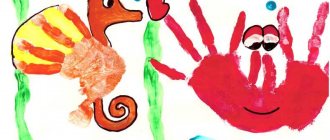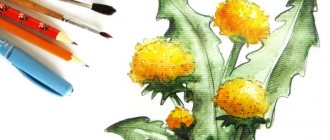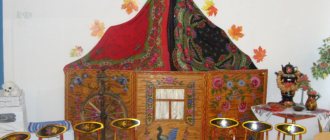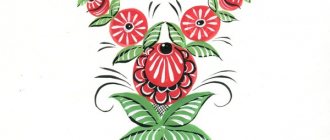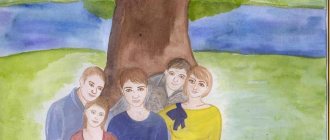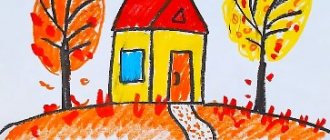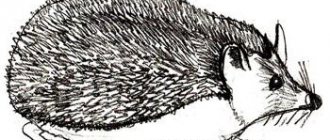Drawing with palms in the senior group: autumn still life. GCD summary, pictures for children, examples of children's work.
Palm painting is an unconventional painting technique that is commonly used with young children. But its capabilities are much wider. Today we will look at how you can use this non-traditional technique in teaching drawing to children of senior preschool age (senior and preparatory kindergarten groups).
Palm painting technique. You will need paints with the consistency of liquid sour cream. The paint is either applied to the child’s palm with a wide brush, or poured into a flat plate into which the child dips his palm. Next, palm prints are made on the paper and they are completed to the desired image. You can finish painting with your fingers or with a regular brush.
Author of the summary: reader of "Native Path" and participant in our competition "Autumn Workshop of Children's Crafts -2015" Lebedeva Elena Nikolaevna, teacher of additional education and teacher-organizer (Moscow GBOU School No. 324 "Firebird" DP kindergarten No. 215 and No. 179 ).
Tasks
— introduce the work of artists who depicted autumn still lifes,
- introduce the basics of color science, teach how to identify cold and warm colors and use shades in your works, introduce the term “saturated colors”,
- strengthen children’s ability to mix watercolor paints, obtain shades of colors and use them in drawings,
— develop children’s compositional skills: learn to place a composition on a non-standard sheet of paper, independently build a composition of a drawing and work it out in color,
— encourage children to boldly experiment, using a palette to mix colors, to find their own vision of the beauty of shapes and objects.
Precautionary measures
Small children get tired quickly; for the first time it is enough to practice for no more than 5 minutes . Further, the child’s attention will not concentrate on creativity. The first few lessons are an adaptation period. You should not set difficult-to-achieve goals while you need to conduct lessons in the form of a game. While drawing, children, with the help of their parents, will be able to study geometric shapes, names of colors, various animals and types of transport, even body parts.
It is important to properly prepare the workplace and monitor the baby. First you need to deal with the paints. If it is watercolor, then it is diluted with water to a paste-like state. Thick gouache should also be made more liquid. Finger paints are ready to use. You can add glitter to them to make drawing more interesting.
It is better to pour the material into a flat saucer or plate. It is difficult for kids to get paint out of a small jar with their fingers; it is much easier to scoop it out of a large bowl. It is recommended to place a bowl of warm, clean water nearby. The child will wash his hands in it in order to continue using a different color. You also need to place a towel nearby, which can be stained with paint.
It is not advisable to leave your baby alone during classes. A small child can be so inventive that he will paint more than just paper . The role of parents during creativity is to channel the children's energy. The mother or father must communicate with the baby, prompt or help him. But you need to be allowed to make mistakes. Let a child draw crookedly or ugly - this is how he still expresses his “I”.
If the baby is not yet a year old, then it is better to provide him with a floor instead of a table. It is advisable to remove the carpet from it and lay down oilcloth. It is also recommended to remove all items that a child could damage. Wardrobes and beds can also be covered with oilcloth, otherwise they may be painted. If parents are afraid that the baby will freeze, you can put a warm blanket under him.
Preparing to paint an autumn still life
The teacher asks the children what time of year there are many bright and rich shades of warm colors in nature; nature literally breathes warmth. This time of year has always attracted artists, poets, and composers with its luxurious beauty; they admired this time of year and conveyed their admiration to people through their vision of the beauty of nature. How many famous people have left us their masterpieces in painting, poetry and music! What time of year do you think it might be? (autumn). What time of year is it now? What autumn months do you know?
What is the difference between early autumn and golden autumn? (In September, autumn is just beginning. The first yellow leaves appear on birches, maples bloom with yellow and red foliage. They say about such an autumn - early autumn. In October, all the trees dress up in autumn outfits, the leaves begin to fall. They say about such an autumn - golden, lush autumn ).
How do we know that late autumn has arrived? (In November, there is almost no foliage on the trees, there are frequent cold rains, frosts set in, and the first snow falls. This is called late autumn).
Autumn has its own colors. What colors of golden autumn do you know? (Red, yellow, orange, green, purple, warm, crimson, golden).
More useful materials for talking with children: A selection of poems about the colors of autumn for drawing classes with preschool children can be found here in the article about drawing an autumn forest using the technique of leaf prints on paper.
The teacher invites children to draw an autumn still life and shows how adult artists and children who are learning to be artists draw still lifes.
How to analyze these still lifes with children: The teacher shows the children a table with warm and cold colors and the still life invites them to think through what color palette the artist tells us about autumn in his still life. Does this painting have more warm or cool colors and shades?
At the end of the conversation, the adult asks: “What colors will you use to tell your story about autumn in your future still life? Think about it, and you and I will begin to draw an unusual autumn still life.
The still life will consist of maple leaves that stand in a vase. We will draw maple leaves using our palms.”
Materials and tools
All materials can be found in any store that sells office supplies. Children do not need professional expensive paints. It is better to choose those with a safe composition, because the child can taste them.
Required tools and materials:
- paper;
- finger or any other paints;
- dry and wet wipes;
- cotton swabs and disks;
- old toothbrushes;
- oilcloth or mat for creativity.
You can choose any paper for drawing - A4 or A3 sheets, Whatman paper, coloring books, colored cardboard. You don’t have to buy expensive goods; just buy a standard album or sketchbook. But the paper in them should be thick so as not to get wet from water. Suitable paints include watercolor, gouache, and special materials for fingers. They can be purchased at any art stores. The colors should be bright; there are watercolors and gouache with glitter. Such materials will interest children. You can draw figures not only with your hands - the child can use cotton pads or sticks, toothbrushes.
It is advisable to seat the baby at a comfortable table, and lay a blanket or pillow on the chair to make him comfortable. It is better to cover the workplace with oilcloth or a special rug. In any case, the children will cover it with paints. It is also recommended to dress the child in old clothes that you don’t mind getting dirty. And to cleanse the skin you need to use dry or wet wipes.
Kids won't be able to draw serious pictures yet.
Their first attempts will resemble meaningless scribbles: dashes, sticks, crooked lines, blots. But the more often the child practices, the more interesting his images will become. With age, technique will improve, and the most talented children will begin to create real masterpieces.
Drawing a mimosa with your fingers
The task will be interesting for children under 3 years old.
Prepare:
- blank drawing
- yellow paint
- glass of water
- a rag or napkins
You can draw a vase, twigs and mimosa leaves yourself or print a blank from the Internet.
- First, tell and show your child what you expect to see at the end of his work. Come up with a story about mimosa, when it blooms, what holiday it is given to your mother for
- Invite your child to draw flowers with his fingers, including those that have not yet bloomed. Help him play with shades of yellow paint for this purpose.
- At the end of the work, praise the child for his efforts. Save the drawing in an album or hang it on the wall in a frame.
Finger drawing toys
- Toys surround the baby from the earliest days. That’s why the desire to draw them settles in the child’s head. It's so fun to depict a helicopter, a car or a bear with a doll walking in the forest or along a green meadow
- You will set the tone and help the baby during a creative flight
- Complete the small details and name the resulting toy. Write a short story about her and her adventures. So your baby will love to draw with you.
Here are some examples of finger painting of different toys:
We train our fingers, trace, draw, write
- This is the title of Alesya Zhukova’s book, which has been mastered and recommended by many parents of preschool and early school-aged children.
- Thanks to a moderate number of tasks, your child will learn to draw geometric shapes, write letters and numbers, count, and evaluate himself by the number of mistakes.
- Your help is still relevant. The tasks are different and may cause difficulties when you first get acquainted with them
The child will master:
- neat drawing technique
- correct and comfortable holding of a pen, pencil, brush
- alphabet and counting
You can purchase the book or find it in the public domain and print it before each lesson.
- Remember, you shouldn’t overload your child; if you notice fatigue on his paper, switch your attention to other activities, go for a walk or give his hands and eyes a rest
- So, we looked at the importance and relevance of regular finger painting classes for kids
- However, dear parents, focus more on the joy and pleasure of joint creativity with your child, rather than on results and achievements
Let your mutual understanding and healthy affection grow stronger every day!
Paint Recipes
The technology called “Finger Painting” involves the use of paints. But many parents worry that they may be dangerous for the child. After all, many kids taste them, and they contain many harmful chemicals.
Some mothers prepare their own paints. The ingredients are quite simple:
- 2 tbsp. flour;
- 1.5 tbsp. water;
- 7 tbsp. l. salt;
- 1.5 tbsp. l. vegetable oil;
- glycerol;
- food colorings.
First you need to mix the dry products - flour and salt. Add water to them and stir until thick sour cream forms. Then add vegetable oil. The ingredients can be mixed with a whisk, fork, mixer or blender. Glycerin is added as desired, it gives the paint shine.
The finished mass is poured into different jars; you can use empty containers from gouache or baby puree. Then you need to add dyes. They can be natural - juice of carrots, beets, celery, turmeric. You can also use food colorings that are added to baked goods.
At home, you can prepare three-dimensional paints for finger painting. You will need few ingredients:
- 1 tbsp. flour;
- 1 tbsp. salt;
- 2 tbsp. water.
The products must be thoroughly mixed and placed in different containers. Then dyes are added to them. For additional shine, glitter or glycerin is added to the mixture. Next, the jars are placed in the microwave for 1.5 minutes at 180 degrees. The result will be a voluminous material. While drawing, the paints will lie on the paper so that any image will acquire a 3D effect.
You can also use porridge for cooking:
- 0.5 tbsp. fine-grained cereals;
- water;
- dyes.
Semolina is suitable for creating paints; it is quite small. It is cooked according to the usual recipe; the consistency of the porridge should resemble sour cream. For greater viscosity, you can add PVA glue to the mixture. The mass is also laid out in small jars and mixed with dyes. This material will also allow you to create three-dimensional drawings. But after applying it to paper, you need to handle the painting more carefully - it must dry. You can fix the cereal with regular hairspray.
Finger painting 2-3 years
After his second anniversary, the baby gets acquainted with geometric shapes and draws them.
In addition, he already speaks and is able to draw for a short time. The baby is already doing a good job with clear lines; he does not use his whole hand in the drawing process, but only his hand and fingers.
It is important to use both hands of the child so that his development occurs harmoniously.
Remind him, encourage him to use his other hand.
Make up stories before starting creative work with your child. For example:
- we draw snowfall, chicken, berries, apples - with this you encourage the baby to draw round shapes
- rain, a fence near the house, rails and sleepers - the baby learns to draw vertical and horizontal lines
- find a specific animal by coloring its silhouette
Other materials for practicing finger art will be:
- semolina, rice, buckwheat
- coffee beans
- Sprinkle a small amount of either of these on the lid of a shoe box.
- Engage your child in the game, be sure to praise him after the work is done


